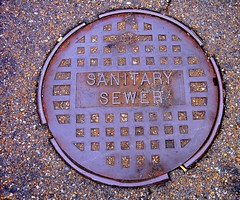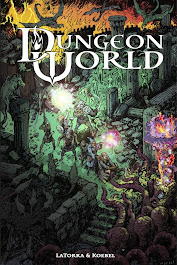Please excuse the title of this post. You see, a couple of weeks back I played Vast & Starlit at Open RPG Night and V&S features a very interesting alien creation mechanic. It works (roughly) like this:
I seem to have gotten ahead of myself, just what is Vast & Starlit? V&S is a nanogame from Epidiah Ravachol and it has a very interesting price tag: $1 and a drawing. The game is tiny, fitting on a single piece of card about twice the size of a business card. It packs a surprisingly large punch for its small size. Within minutes we had created our merry band of escaped convicts and were soaring through space on The Warden's Wife.
I can't really say too much about the game's mechanics. It's only about 400 words long and anything particularly descriptive here might just as well be a scanned copy of the game. What I can tell you is that it is very much on the story game end of the spectrum. It has no fixed GM and players take turns establishing scenes and determining outcomes. There is no dice rolling, bidding, point economy or other gaming structures to get in the way. Players simply take turns setting up pieces, guided by V&S' rules, and role play things out. The result s a fun and quick game that occasionally left me wishing for Fate's cruel hand to throw me a curve ball.
The lack of a random element really is this game's greatest weakness. Vast & Starlit does a great job of giving the players a lot of elements to jam off of, but a problem arises when it is time to end a conflict scene. One of the players chooses whether something is dangerous, difficult or both and then events proceed based on specific requirements for those three scenarios. The trouble with this is that as a player involved in the game I felt bad about being cruel to the other player characters. I didn't want to kill or maim them and there seemed to be a similar reluctance coming from the other players at the table. Without that die roll to take the blame, even if the odds would have been terrible, conflict didn't have sharp enough teeth. This would have been less of an issue had a I been playing with my regular group, rather than the ragtag band of RPG enthusiasts that showed up for Open RPG Night, as I would have known where my fellow player's limits were.
Vast & Starlit is fun and it is tiny. It isn't a game that I see myself coming back to very often, but I don't think it needs to be. It will sit on my gaming shelf and wait for its time to shine. I'm filing this one away in the "use in case of absent player(s)" box. I say it's worth getting your hands on, if only as an excuse to draw some terrible pictures and snail mail them away.
- Every player names an animal they are familiar with.
- Each player, in turn, picks one of the animals and singles out a defining feature. Another player then chooses to either exaggerate or invert that feature.
- This is repeated until each animal has been picked over.
- The results are combined into some kind of bizarre creature.
I seem to have gotten ahead of myself, just what is Vast & Starlit? V&S is a nanogame from Epidiah Ravachol and it has a very interesting price tag: $1 and a drawing. The game is tiny, fitting on a single piece of card about twice the size of a business card. It packs a surprisingly large punch for its small size. Within minutes we had created our merry band of escaped convicts and were soaring through space on The Warden's Wife.
I can't really say too much about the game's mechanics. It's only about 400 words long and anything particularly descriptive here might just as well be a scanned copy of the game. What I can tell you is that it is very much on the story game end of the spectrum. It has no fixed GM and players take turns establishing scenes and determining outcomes. There is no dice rolling, bidding, point economy or other gaming structures to get in the way. Players simply take turns setting up pieces, guided by V&S' rules, and role play things out. The result s a fun and quick game that occasionally left me wishing for Fate's cruel hand to throw me a curve ball.
The lack of a random element really is this game's greatest weakness. Vast & Starlit does a great job of giving the players a lot of elements to jam off of, but a problem arises when it is time to end a conflict scene. One of the players chooses whether something is dangerous, difficult or both and then events proceed based on specific requirements for those three scenarios. The trouble with this is that as a player involved in the game I felt bad about being cruel to the other player characters. I didn't want to kill or maim them and there seemed to be a similar reluctance coming from the other players at the table. Without that die roll to take the blame, even if the odds would have been terrible, conflict didn't have sharp enough teeth. This would have been less of an issue had a I been playing with my regular group, rather than the ragtag band of RPG enthusiasts that showed up for Open RPG Night, as I would have known where my fellow player's limits were.
Vast & Starlit is fun and it is tiny. It isn't a game that I see myself coming back to very often, but I don't think it needs to be. It will sit on my gaming shelf and wait for its time to shine. I'm filing this one away in the "use in case of absent player(s)" box. I say it's worth getting your hands on, if only as an excuse to draw some terrible pictures and snail mail them away.





























